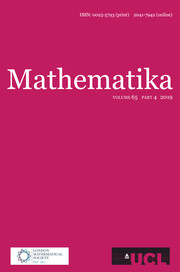Article contents
A DICHOTOMY LAW FOR THE DIOPHANTINE PROPERTIES IN  $\unicode[STIX]{x1D6FD}$ -DYNAMICAL SYSTEMS
$\unicode[STIX]{x1D6FD}$ -DYNAMICAL SYSTEMS
Published online by Cambridge University Press: 16 May 2016
Abstract
Let  $\unicode[STIX]{x1D6FD}>1$ be a real number and define the
$\unicode[STIX]{x1D6FD}>1$ be a real number and define the  $\unicode[STIX]{x1D6FD}$ -transformation on
$\unicode[STIX]{x1D6FD}$ -transformation on  $[0,1]$ by
$[0,1]$ by  $T_{\unicode[STIX]{x1D6FD}}:x\mapsto \unicode[STIX]{x1D6FD}x\,\text{mod}\,1$ . Further, define
$T_{\unicode[STIX]{x1D6FD}}:x\mapsto \unicode[STIX]{x1D6FD}x\,\text{mod}\,1$ . Further, define  $$\begin{eqnarray}W_{y}(T_{\unicode[STIX]{x1D6FD}},\unicode[STIX]{x1D6F9}):=\{x\in [0,1]:|T_{\unicode[STIX]{x1D6FD}}^{n}x-y|<\unicode[STIX]{x1D6F9}(n)\text{ for infinitely many }n\}\end{eqnarray}$$
$$\begin{eqnarray}W_{y}(T_{\unicode[STIX]{x1D6FD}},\unicode[STIX]{x1D6F9}):=\{x\in [0,1]:|T_{\unicode[STIX]{x1D6FD}}^{n}x-y|<\unicode[STIX]{x1D6F9}(n)\text{ for infinitely many }n\}\end{eqnarray}$$ $$\begin{eqnarray}W(T_{\unicode[STIX]{x1D6FD}},\unicode[STIX]{x1D6F9}):=\{(x,y)\in [0,1]^{2}:|T_{\unicode[STIX]{x1D6FD}}^{n}x-y|<\unicode[STIX]{x1D6F9}(n)\text{ for infinitely many }n\},\end{eqnarray}$$
$$\begin{eqnarray}W(T_{\unicode[STIX]{x1D6FD}},\unicode[STIX]{x1D6F9}):=\{(x,y)\in [0,1]^{2}:|T_{\unicode[STIX]{x1D6FD}}^{n}x-y|<\unicode[STIX]{x1D6F9}(n)\text{ for infinitely many }n\},\end{eqnarray}$$ $\unicode[STIX]{x1D6F9}:\mathbb{N}\rightarrow \mathbb{R}_{{>}0}$ is a positive function such that
$\unicode[STIX]{x1D6F9}:\mathbb{N}\rightarrow \mathbb{R}_{{>}0}$ is a positive function such that  $\unicode[STIX]{x1D6F9}(n)\rightarrow 0$ as
$\unicode[STIX]{x1D6F9}(n)\rightarrow 0$ as  $n\rightarrow \infty$ . In this paper, we show that each of the above sets obeys a Jarník-type dichotomy, that is, the generalized Hausdorff measure is either zero or full depending upon the convergence or divergence of a certain series. This work completes the metrical theory of these sets.
$n\rightarrow \infty$ . In this paper, we show that each of the above sets obeys a Jarník-type dichotomy, that is, the generalized Hausdorff measure is either zero or full depending upon the convergence or divergence of a certain series. This work completes the metrical theory of these sets.
MSC classification
Information
- Type
- Research Article
- Information
- Copyright
- Copyright © University College London 2016
References
- 8
- Cited by

